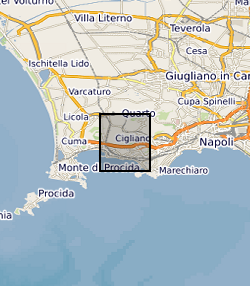Gravity
Type of resources
Topics
Keywords
Contact for the resource
Provided by
Years
Formats
Representation types
Update frequencies
Scale
Resolution
-

The data set contains location (latitude and longitude), ellipsoidal height (m) and observed gravity of benchmarks at the Campi Flegrei caldera, Italy. The gravity and location data were collected between 8 and 12 July, 2015 using a Scintrex CG5 gravimeter (serial number: 572) in tandem with a TOPCON HiPer Pro Dual-Frequency GNSS base and rover system. The survey contained a total of 85 benchmarks in addition to the base station.
-
During the 2010/2011 Antarctic field season a collaborative NERC AFI (Antarctic Funding Initiative) project studying the basal boundary conditions of the Institute & Moller ice streams, West Antarctica, collected ~25,000 km of new high quality aerogravity data. Data were acquired using Lacoste and Romberg air-sea gravity meter S83, mounted in the BAS aerogeophysically equipped Twin Otter "Bravo Lima". Data are provided as XYZ ASCII line data. Data were collected as part of the UK Natural Environment Research Council AFI grant NE/G013071/1.
-
A British Antarctic Survey Twin Otter and survey team acquired 15,500 line-km of aerogeophysical data during the 2001/02 Antarctic field season along a 1-km line spacing grid with tie-lines 8 km apart. Twenty-five flights were flown from the South African base SANAE, for a total of 100 survey hours. We present here the processed line aerogravity data acquired using a LaCoste & Romberg air-sea gravity meter S83 mounted in the BAS aerogeophysically equipped Twin Otter aircraft. Data are provided as XYZ ASCII line data. This high-resolution aerogeophysical survey was part of the "Magmatism as a Monitor of Gondwanabreak-up" project (MAMOG) of the British Antarctic Survey, which included new geochemical investigations, structural geology, geochronology, and AMS studies over western Dronning Maud Land.
-
During the austral summer of 2004/05 a collaborative US/UK field campaign undertook a systematic geophysical survey of the entire Amundsen Sea embayment using comparable airborne survey systems mounted in Twin Otter aircraft. Here we present the portion of the survey covering the Pine Island Glacier basin led by British Antarctic Survey. Operating from a temporary field camp (PNE, S 77deg34'' W 095deg56''; we collected ~35,000 km of airborne survey data. Our aircraft was equipped with dual-frequency carrier-phase GPS for navigation, radar altimeter for surface mapping, wing-tip magnetometers, gravity meter, and a new ice-sounding radar system (PASIN). We present here the processed line aerogravity data collected using a LaCoste & Romberg air-sea gravity meter S83 mounted in the BAS aerogeophysically equiped Twin Otter aircraft. Data are provided as XYZ ASCII line data.
-
During the 2001-02 field season a regional survey was flown on a 10 km line spacing grid over the drainage basin of the Rutford Ice stream (West Antarctica), as part of the TORUS (Targeting ice stream onset regions and under-ice systems) project. We present here the processed line aerogravity data collected using a LaCoste & Romberg air-sea gravity meter S83 mounted in the BAS aerogeophysically equipped Twin Otter aircraft. Data are provided as XYZ ASCII line data.
-
Long-range airborne geophysical measurements were carried out in the ICEGRAV campaigns (2010-2013), covering hitherto unexplored parts of interior East Antarctica and part of the Antarctic Peninsula. The airborne surveys provided a regional coverage of gravity, magnetic and ice-penetrating radar measurements for major Dronning Maud Land ice stream systems, from the grounding lines up to the Recovery Lakes drainage basin, and filled in major data voids in Antarctic data compilations.We present here the processed line aerogravity data collected using a LaCoste & Romberg air-sea gravity meter S83 mounted in the BAS aerogeophysically equipped Twin Otter aircraft. Data are provided as XYZ ASCII line data.
-

The dataset comprises: Petrophysical data for rocks from the region, XRD mineralogical data, Results of the gravity survey of the basin, tabulation and location of all bedding orientation data for the basin, and sediment transport lineation data. The dataset accompanies publication : On the Structure and Evolution of the Sorbas Basin, S.E. Spain, Tectonophysics 773 (2019) 228230, DOI: https://doi.org/10.1016/j.tecto.2019.228230
-
This geophysical survey has been carried out by Digicon Geophysical, for British Geological Survey (BGS), the Multichannel Deep Seismic survey took place from July to August 1993 in the Rockall area on board the MV Acadian Searcher. The purpose was to collect data as part of Rockall Continental Margin Project: 1) to shoot a grid of lines on eastern flank of Rockall Bank; 2) to shot three long transect lines across Rockall Bank and the Rockall-Hatton Basin down to 18sec two-way time; 3) to acquire gravity data. Sub-bottom profiling data were collected using Airguns. Gravity data were collected. These data were recorded digitally and are archived by BGS. Technical details of the survey are contained in BGS report WB/93/28C and contractor report. GeoIndex Offshore - https://mapapps2.bgs.ac.uk/geoindex_offshore/home.html?cruise=1993/2_RCK&.
-
This marine geophysical survey took place from 03/05/1992 – 10/07/1992 in the Rockall Continental Margin on board the Kommandor Michael. The survey was carried out by the British Geological Survey (BGS). The aim of the survey was to investigate the shallow seismic structure along the eastern margin of the Rockall Bank, Northern Rockall Trough and adjacent banks. Sub bottom seismic profiling data were collected using Airgun, Sparker and Deep Tow Boomer systems. Gravity and Magnetic data were also acquired. These data are archived by BGS. Technical details of the survey are contained in BGS Technical Report WB/92/20C. Brett, CP and Dobinson, A. 1992. Rockall Continental Margin Project. Operations Report. GeoIndex Offshore - https://mapapps2.bgs.ac.uk/geoindex_offshore/home.html?cruise=1992/1_RCK.
-
Report: Bacon, M. 1971. Irish Sea Refraction Experiments. MGU Project 71/04. (IGS Report No 19) Positioning: Presumed to be Decca Mainchain Echo sounding: No information but may have been ORE sub-bottom profiler as on previous cruise 71/03. Seismic systems: Refraction ICI Aquaseis was the explosive source with UEL sonobuoys. No digital navigation data for this. Gravitymeter: LaCoste and Romberg gravity meter. Magnetometer: Barringer magnetometer
 NERC Data Catalogue Service
NERC Data Catalogue Service